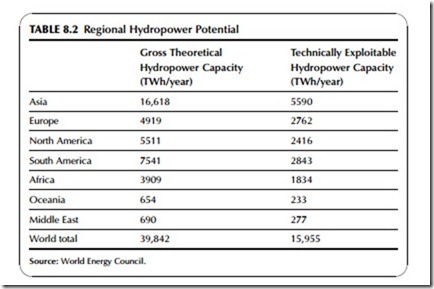HYDROPOWER RESOURCE
The energy that is extracted from water by a hydropower plant and converted into electricity is potential energy contained within the mass of water as a con- sequence of its elevation. This energy is released as the water flows downhill, normally being dissipated in various ways within the watercourse down which it flows. A hydro-turbine can extract some of this energy and use it to produce electric power.
The water flow is created, in the final instance at least, by rainfall, but the water vapor in clouds that is the source of rain is raised into the atmosphere by the effect of the sun’s heat on the world’s seas and other water surfaces. Solar energy generates the heat that vaporizes the water and lifts it into the high atmosphere, generating the potential energy that is available later for release. There- fore, hydropower is ultimately a form of solar power.
When estimating how much electricity might potentially be available from hydropower resources, a number of measures are commonly used. One is the gross theoretical hydropower potential. The gross theoretical hydropower potential of a region is the total amount of energy that would be released each year if all the energy contained in rain falling across the region was exploited to sea level at the borders of the region. Carrying out the calculation to sea level maximizes the energy available.
There are technical, economic, and environmental reasons why this gross capacity can never be fully realized. A second measure, the technically exploit- able hydropower capacity, provides a more realistic figure for the amount that might eventually be used. This is a measure of the capacity that could be exploited using currently available technology. Regional technically exploit- able hydropower capacities are also shown in Table 8.2. These are significantly smaller than the gross theoretical capacities. Across Asia, the technically exploitable capacity is 5590 TWh/year, 34% of the gross theoretical capacity. Technical capacities in other regions are similarly reduced compared to the gross capacity.
Cost may further reduce the potential capacity since some technically exploitable hydropower sites will be too costly to develop. A further measure of potential capacity that takes account of this is the economically exploitable hydropower capacity. The global economically exploitable hydropower capac- ity has been estimated to be about 13,100 TWh/year.3 There may be still further limits on development as a result of environmental concerns or other under one-third of the exploitable potential. On this basis, two-thirds of exploit- able global potential remain to be developed. However, while such estimates are useful guides, all these potential figures should be treated as approximations because there is no general consensus about how such estimates should be made.
Regional levels of hydropower exploitation vary widely. The most highly developed region is Europe where, based on World Energy Council figures from 2010, 26% of the technically exploitable potential has been developed, followed by North and Central America with 22%. South America has exploited 20% of its technical potential and Oceania 21%, but Asia has only exploited 13%, the Middle East 10%, and Africa 5%.
Global installed hydropower capacity was estimated to be just under 1000 GW at the end of 2012. The most recent breakdown of this capacity by region is from 2008, and shown in Table 8.1. This shows that Asia has the greatest installed capacity, 307 GW in total. Over half of this (171 GW) was in China. Europe has the second largest gross capacity with 221 GW. The capacity in North America at the end of 2008 was 168 GW, with 73 GW of this in Canada and 77 GW in the United States. South America had 132 GW, dominated by Brazil with 76 GW. Against these figures the total in Africa, 22 GW, reflects the low level of exploitation on that continent. There are also small capacities in both Oceania and the Middle East as shown in the table.
